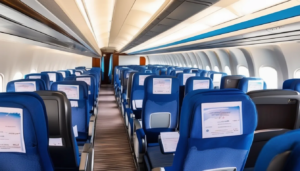
When you’re buying plane tickets, it’s easy to overlook details that can lead to unexpected costs and hassle. You might think booking early guarantees the best price, but timing your purchase and comparing different airlines can make a significant difference. Plus, those extra fees for baggage and seat selection can add up quickly, turning a seemingly great deal into a budget buster. If you want to ensure a smooth travel experience, understanding how to navigate these common pitfalls is crucial. So, what should you watch out for next? خرید بلیط هواپیما.
Understanding Price Fluctuations
When it comes to buying plane tickets, many travelers notice that prices can change dramatically from one day to the next. Understanding why this happens can help you snag a better deal. Airlines use complex algorithms that analyze various factors, such as demand, competition, and booking patterns.
When more people search for a specific flight, prices might rise due to increased demand. Conversely, if a flight isn’t selling well, prices may drop to entice more buyers.
You might also find that prices fluctuate based on the season, day of the week, or time of day. For instance, ticket prices often spike during holidays or weekends when travel is at its peak. If you’re flexible with your travel dates, you can take advantage of lower fares on less popular days.
Additionally, airlines often engage in dynamic pricing, which means they adjust prices in real-time based on seat availability and competitor rates. This constant change can make it tricky to find the best price.
Choosing the Right Time to Buy
Timing is crucial when it comes to buying plane tickets, and knowing the best moments to book can save you a significant amount of money. Generally, booking your flight about six to eight weeks in advance is ideal, as this is when airlines often offer their best deals. However, prices can vary based on your destination and travel season.
To help you decide when to book, here’s a simple guide:
| Booking Timeframe | Best Time to Buy | Price Trend |
|---|---|---|
| 3-6 months ahead | Early booking | Prices start high |
| 6-8 weeks ahead | Sweet spot | Prices drop significantly |
| 2-3 weeks ahead | Last-minute deals | Prices may rise |
| 1 week or less | Risky, often high | Prices peak |
Keep an eye on fare alerts and be flexible with your travel dates if you can. Sometimes, flying on weekdays or during off-peak times can lead to better prices. Remember, the key is to stay informed and act when you see a great deal!
Comparing Different Airlines
As you plan your trip, comparing different airlines can make a big difference in your overall travel experience and costs.
Start by looking at the airlines that serve your route. Some may offer more direct flights, while others might involve layovers that can add time to your journey.
Next, check the flight schedules. Flexibility can save you money, so consider flying on weekdays or during off-peak times when prices are typically lower.
Keep an eye on the duration of flights as well; shorter flights can be more convenient, even if they’re slightly more expensive.
Don’t forget to research the airline’s reputation. Read reviews to see what other travelers say about their experiences, including customer service and punctuality.
If you’re traveling with family or friends, consider how the airline accommodates groups, as this can enhance your travel experience.
Being Aware of Extra Fees
Extra fees can quickly add up, so it’s crucial to be aware of them before booking your flight. When you’re comparing airline prices, don’t just look at the ticket price itself. Many airlines charge for checked bags, seat selections, and even carry-on luggage. You might think you’re snagging a great deal, but by the time you add in these costs, that bargain ticket can turn into a pricey option.
Make sure to read the fine print on the airline’s website. Some airlines also impose fees for things like in-flight meals, entertainment, and priority boarding. If you plan to make any changes to your itinerary, be prepared for potential change fees, which can be steep.
Another common pitfall isn’t considering payment methods; some airlines charge extra if you use a credit card. Before you finalize your booking, calculate the total cost to avoid any surprises later on.
Evaluating Flight Connections and Layovers
When planning your trip, evaluating flight connections and layovers is essential for a smooth travel experience.
First, consider the duration of your layover. A short connection might save time, but if your initial flight is delayed, you could miss your next one. Aim for at least an hour for domestic flights and two hours for international ones.
Next, check the airport layout. Large airports may require more time to navigate between terminals. If you’re transferring between different airlines, make sure they’re in the same terminal to avoid extra hassle.
Also, factor in customs and security checks, which can add time to your layover.
Don’t forget to assess the quality of the layover. Some airports offer amenities like lounges, restaurants, and shops that can make your wait more pleasant.
If you have a longer layover, you might even explore the city, but ensure you have enough time to return for your next flight.
Conclusion
In conclusion, buying plane tickets doesn’t have to be a hassle. By understanding price fluctuations, choosing the right time to book, and comparing different airlines, you can snag the best deals. Don’t forget to keep an eye out for extra fees that can sneak up on you. Finally, evaluate your flight connections and layovers to ensure a smooth journey. With these tips, you’ll travel smarter and enjoy your trip without breaking the bank!





